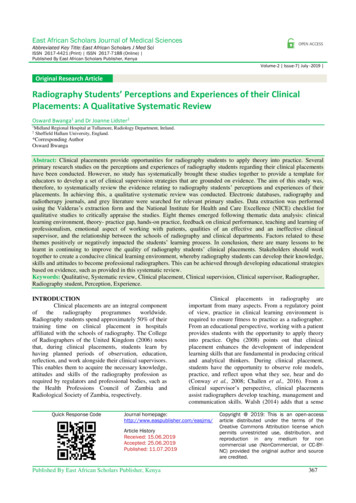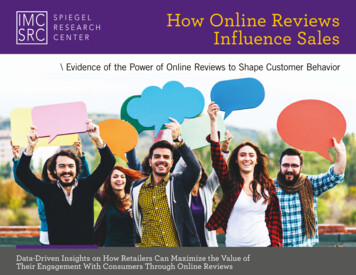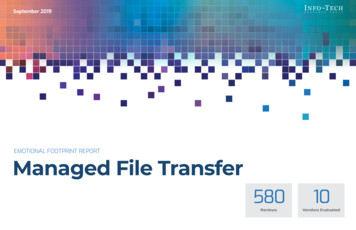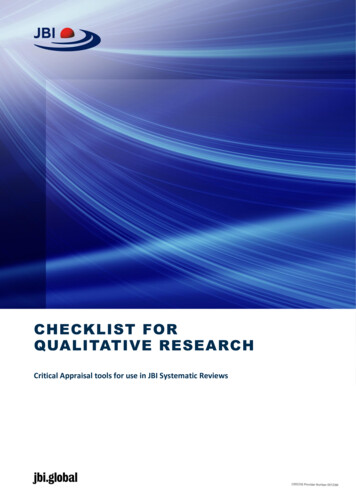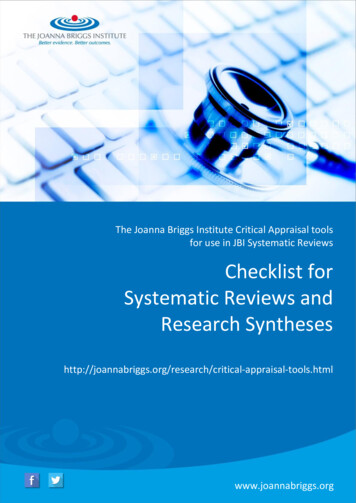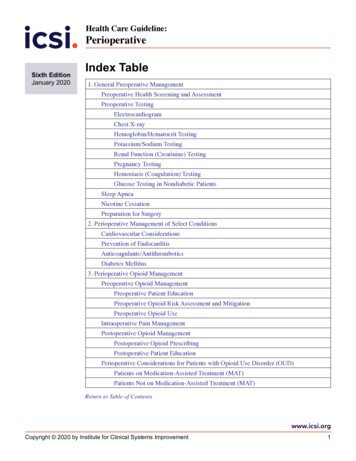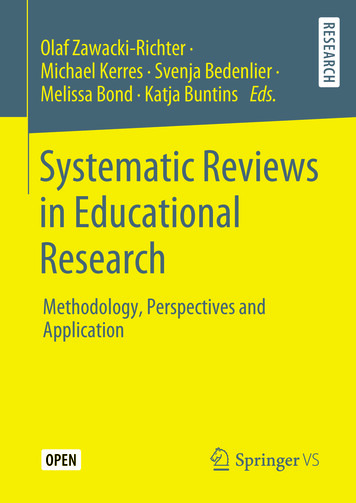
Transcription
Olaf Zawacki-Richter ·Michael Kerres · Svenja Bedenlier ·Melissa Bond · Katja Buntins Eds.Systematic Reviewsin EducationalResearchMethodology, Perspectives andApplication
Systematic Reviews in EducationalResearch
Olaf Zawacki-Richter · Michael Kerres ·Svenja Bedenlier · Melissa Bond ·Katja BuntinsEditorsSystematic Reviews inEducational ResearchMethodology, Perspectives andApplication
EditorsOlaf Zawacki-RichterOldenburg, GermanyMichael KerresEssen, GermanySvenja BedenlierOldenburg, GermanyMelissa BondOldenburg, GermanyKatja BuntinsEssen, GermanyISBN 978-3-658-27601-0ISBN 978-3-658-27602-7 ringer VS The Editor(s) (if applicable) and The Author(s) 2020. This book is an open access publication.Open Access This book is licensed under the terms of the Creative Commons Attribution 4.0International License (http://creativecommons.org/licenses/by/4.0/), which permits use, sharing,adaptation, distribution and reproduction in any medium or format, as long as you give appropriate credit to the original author(s) and the source, provide a link to the Creative Commons licenseand indicate if changes were made.The images or other third party material in this book are included in the book’s CreativeCommons license, unless indicated otherwise in a credit line to the material. If material is notincluded in the book’s Creative Commons license and your intended use is not permitted bystatutory regulation or exceeds the permitted use, you will need to obtain permission directlyfrom the copyright holder.The use of general descriptive names, registered names, trademarks, service marks, etc. in thispublication does not imply, even in the absence of a specific statement, that such names areexempt from the relevant protective laws and regulations and therefore free for general use.The publisher, the authors and the editors are safe to assume that the advice and information inthis book are believed to be true and accurate at the date of publication. Neither the publishernor the authors or the editors give a warranty, expressed or implied, with respect to the materialcontained herein or for any errors or omissions that may have been made. The publisher remainsneutral with regard to jurisdictional claims in published maps and institutional affiliations.This Springer VS imprint is published by the registered company Springer Fachmedien WiesbadenGmbH part of Springer Nature.The registered company address is: Abraham-Lincoln-Str. 46, 65189 Wiesbaden, Germany
Introduction: Systematic Reviewsin Educational ResearchIntroductionIn any research field, it is crucial to embed a research topic into the broaderframework of research areas in a scholarly discipline, to build upon the body ofknowledge in that area and to identify gaps in the literature to provide a rationalefor the research question(s) under investigation. All researchers, and especiallydoctoral students and early career researchers new to a field, have to familiarizethemselves with the existing body of literature on a given topic. Conducting asystematic review provides an excellent opportunity for this endeavour.As educational researchers in the field of learning design, educational technology, and open and distance learning, our scholarship has been informedby quantitative and qualitative methods of empirical inquiry. Some of the colleagues in our editorial team were familiar with methods of content analysis usingtext-mining tools to map and explore the development and flow of research areasin academic journals in distance education, educational technology and international education (e.g., Zawacki-Richter and Naidu 2016; Bond and Buntins 2018;Bedenlier et al. 2018). However, none of us was a practitioner or scholar of systematic reviews, when we came across a call for research projects by the GermanMinistry of Education and Research (BMBF) in 2016.The aim of this research funding program was to support empirical researchon digital higher education, and the effectiveness and effects of currentapproaches and modes of digital delivery in university teaching and learning. Furthermore, it was stated in the call for research projects:In addition, research syntheses are eligible for funding. Systematic synthesis of thestate of international research should provide the research community and practitioners with knowledge on the effects of certain forms of learning design withv
viIntroduction: Systematic Reviews in Educational Researchregard to the research areas and practice in digital higher education described below.Where the research or literature situation permits, systematic reviews in the narrower methodological sense can also be funded (BMBF 2016, p. 2).What is meant here by “systematic reviews in the narrower methodologicalsense”? In contrast to traditional or narrative literature reviews, that are criticisedas being biased and arbitrary, the aim of a systematic review is to carry out areview that is rigorous and transparent in each step of the review process, to makeit reproducible and updateable. “Rather than looking at any study in isolation, weneed to look at the body of evidence” (Nordenbo 2009, p. 22) to show systematically that existing primary research results contain arguments to shape and informpractice and policies.The review question of our systematic review project was concerned with student engagement and educational technology in higher education (see Chap. 7). Itbecame obvious very quickly, that we were dealing with very broad and “fuzzy”concepts here, travelling within an interdisciplinary domain using inconsistentterminology, which made it difficult to develop a very straightforward searchstrategy. The PICO framework developed in evidence-based medicine and healthscience (Schardt et al. 2007) to define the population, the intervention, the comparator and outcome or impact of an intervention is less useful in many educational review studies, where there is no clear ‘treatment’ (e.g. a drug) that leadsto a well-defined outcome (e.g. the patient is dead or not dead). Study results areoften qualitative in nature or the variance of the different variables at work in aneducational setting is too complex to calculate a simple combining effect sizeacross studies in a meta-analysis (see Borenstein et al. 2009).The Purpose and Structure of this BookGiven the growing interest in conducting systematic reviews in order to informpolicy, and to support research and practice in education (Polanin et al. 2017), thepurpose of this volume is to explore the methodology of systematic reviews, aswell as the opportunities and challenges of doing a systematic review, in the context of educational research.Thus, this book is divided into two sections: Authors in the first part provide an overview of various methodological aspects of systematic reviews.We approach this topic from different perspectives. Scholars of the systematicreview method (see Chaps. 1, 2 and 3) introduce us to the steps involved in thesystematic review process and elaborate on the advantages and disadvantages of
Introduction: Systematic Reviews in Educational Researchviidifferent types of literature reviews, as well as criticisms and ethical dimensionsof systematic reviews. One colleague (see Chap. 4) writes about the pedagogy ofmethodological learning and teaching systematic reviews. And finally, editors ofa very prestigious educational research journal (see Chap. 5) write about the benefits of publishing systematic reviews and share some positive examples that canserve as guidelines for researchers new to systematic reviews, in order to get theirwork published in a peer-reviewed journal.Reading about a method in a research methods textbook is one thing, actuallyapplying a method and doing the research in a specific context is another. Thus,for the second part of the book, we invited educational researchers coming fromeducational psychology, educational technology, instructional design and highereducation research to share their experiences as worked examples, and to reflecton the promises and pitfalls in each step of the review process. We hope that theseexamples will be particularly helpful and can serve as a kind of roadmap for colleagues who are conducting a systematic review for the first time.Part I: Methodological considerationsIn the first Chapter, Mark Newman and David Gough from the University CollegeLondon Institute of Education, introduce us to the method of systematic review.Depending on the aims of a literature review, they provide an overview of variousapproaches in review methods. In particular, they explain the differences betweenan aggregative and configurative synthesis logic that are important for reviews ineducational research. We are guided through the steps in the systematic reviewprocess that are documented in a review protocol: defining the review question,developing the search strategy, the search string, selecting search sources anddatabases, selecting inclusion and exclusion criteria, screening and coding ofstudies, appraising their quality, and finally synthesizing and reporting the results.Martyn Hammersley from the Open University in the UK offers a criticalreflection on the methodological approach of systematic reviews in the secondchapter. He begins his introduction with a historical classification of the systematic review method, in particular the evidence-based medicine movement inthe 1980s and the role of rigorous Randomised Controlled Trials (RCTs). Heemphasises that in the educational sciences RCTs are rare and alternative waysof synthesising research findings are needed, including evidence from qualitativestudies. Two main criticisms of systematic reviewing are discussed, one comingfrom qualitative and the other from realist evaluation researchers. In light of these
viiiIntroduction: Systematic Reviews in Educational Researchcriticisms, Hammersley continues to reflect on the methodological features ofsystematic reviews, in relation to exhaustive searching for relevant material, thetransparent methodological assessment of studies, and the synthesis of findings.In the third chapter, Harsh Suri from Deakin University in Australia elaborateson ethical issues that might be involved in the systematic review process. Systematic reviews are widely read and cited in documents that have an impact on educational policy and practice. Authors have to reveal potential conflicts of interestand reflect on if or how the agenda of a funding source might influence the reviewprocess and the synthesis of findings, including various publication and searchbiases.Melanie Nind from the Southampton University Education School in the UK,writes about teaching the systematic review method in Chap. 4. Given the growing interest in systematic reviewing, it is necessary to reflect on methodologicallearning and teaching, especially on the level of postgraduate and doctoral education. She concludes: “Teaching systematic review, as with teaching many socialresearch methods, requires deep knowledge of the method and a willingness to bereflexive and open about its messy realities; to tell of errors that researchers havemade and judgements they have formed” (p. 66). We will dig deeper into these“messy realities” of doing a systematic review in the second part of this book.The first section on methodological considerations finishes with some enlightening reflections from Alicia Dowd and Royel Johnson, both from Pennsylvania State University in the USA, on publishing systematic reviews from aneditor’s and reader’s perspective. Alica is an Associate Editor of the Review ofEducational Research (RER), the highest impact factor journal within the SSCIEducation & Educational Research category. The overall trend, in terms of theproportion of the total number of reviews published as systematic review articles in RER, has been upward as well. Both authors stress that systematic reviewauthors should ‘story’ their findings in compelling ways, rather than reporting facts in mechanical and algorithmic terms. Examples of how to do this, areillustrated by selected papers from RER. To get published in a journal like RER,requires of course rigorous application of the review or meta-analysis method.However, the authors of this chapter remind us, that we should try not to get tooexhausted by the time- and labour-consuming tasks involved in the systematicreview process, and thereby neglect to put much effort into the ‘storying’ of thesynthesis, discussion and implication sections in a review.
Introduction: Systematic Reviews in Educational ResearchixPart II: Examples and ApplicationsFor Chaps. 6, 7, 8 and 9, we invited authors to write about their practical experiences in conducting systematic reviews in educational research. Along the linesof the subsequent steps in the systematic review method, they discuss variouschallenges, problems and potential solutions: The first example in Chap. 6 is provided by Joanna Tai, Rola Ajjawi, MargaretBearman, and Paul Wiseman from Deakin University in Australia. They carried out a systematic review about the conceptualisations and measures of student engagement. Svenja Bedenlier and co-authors from the University of Oldenburg and theUniversity of Duisburg-Essen in Germany also dealt with student engagement,but they were more interested in the role that educational technology can playto support student engagement in higher education (Chap. 7). Chung Kwan Lo from the University of Hong Kong reports on a series of fivesystematic reviews in Chap. 8 that he has worked on in different teams. Theywere investigating the application of video-based lectures (flipped learning) inK-12 and higher education in various subject areas. Naska Goagoses and Ute Koglin from the University of Oldenburg in Germany share the last example in Chap. 9, which addresses the topic of socialgoals and academic success.Common challenges of systematic reviews in education that derive from thesereports are summarized in the remainder of this introduction.Critical Aspects and Common Challenges of SystematicReviews in EducationAs the systematic review examples that are described in this book show, carrying out a systematic review is a labour-intensive exercise. In a study on the timeand effort needed to conduct systematic reviews, Borah et al. (2017) analysed 195systematic reviews of medical interventions. They report a mean time to completea systematic review project and to publish the review of 67.3 weeks (SD 31.0;range 6–186 weeks). Interestingly, reviews that reported funding took longer (42vs 26 weeks) and involved more team members (6.8 vs 4.8 persons) than reviewsthat reported no funding. The most time-consuming task, after the removal of
xIntroduction: Systematic Reviews in Educational ResearchFig. 1 Literature filtration process (N 195; Borah et al. 2017, p. 4)duplicates from different databases, is the screening and coding of a large numberof references, titles, abstracts and full papers. As shown in Fig. 1 from the Borahet al. (2017) study, a large number of full papers (median 63, maximum 4385)have to be screened to decide if they meet the final inclusion criteria. The filteringprocess in each step of the systematic review can be dramatic. Borah et al. reporta final average yield rate of below 3%.The examples of systematic reviews in educational research presented in thisvolume, echo the results of Borah et al. (2017) from the medical field. Compared to these numbers, the reviews included in this book represent the fullrange; from smaller systematic reviews that were finished within a couple ofmonths, with only five included studies, to very large systematic reviews thatwere carried out by an interdisciplinary team over a time period of two years,including over 70,000 initial references and 243 finally included studies. Table 1provides an overview of the topics, duration, team size, databases searched andthe filtration process of the educational systematic review examples presented inChaps. 6, 7, 8 and 9.Based on our authors’ accounts and reflection on the sometimes thorny path ofconducting systematic reviews, some recurrent issues we have to deal with especially in the field of educational research can be identified.
Lo (Chap. 8)Goagoses and Koglin(Chap. 9)18 months4 authors, 1 researchassistant4,1921864.44%psycINFO, ERIC, Educa- ERIC, Web of Science,tion Source, and Academic psycINFO, and SCOPUSSearch Complete wereaccessed via Ebscohost,Scopus, Web of ScienceDurationNo of team membersInitial referencesFinal referencesYield rateDatabasessearched0.31%24377,5085 authors, 2 researchassistants24 monthsConceptualization andmeasurement of studentengagement1.14%262,2702 authors11 monthsWeb of Science CoreAcademic Search ComCollection, Scopus, andplete, TOC Premier, andpsycINFOERIC, PubMed, psycINFO, CINAHL Plus,and British Nursing Index0.05–1.51%5–61936–40531–3 authors1–4 monthsStudent engagement and Flipped and video-based Social goals and academiceducational technology in learning in various subject successareas in higher educationhigher educationBedenlier et al. (Chap. 7)TopicTai et al. (Chap. 6)Table 1 Comparison of educational systematic review examplesIntroduction: Systematic Reviews in Educational Researchxi
xiiIntroduction: Systematic Reviews in Educational ResearchThe perhaps major challenge of conducting systematic reviews in educational research is the ‘messiness’, which is inherent in domains that use inconsistent terminology and multifaceted concepts like ‘student engagement’ or‘educational technology’ (see Chap. 6 and 7). In such cases, it is crucial to findthe right balance between comprehensiveness and relevance, or sensitivity andprecision (Brunton et al. 2012), in developing the search strategy. For example,Bedenlier et al. (Chap. 7) decided to leave out any phrase relating to studentengagement in the search string and to search for indicators of engagementand disengagement instead. The broadness of this approach made it possible tofind research that would have been missed with a more precise search focus on‘engagement’: only 26% of the finally included studies in their review explicitlyused the term ‘student engagement’ in the title or abstract.As already mentioned above, there is often not a clear intervention and outcome in educational research projects in the sense of variable x leads to y.Reviews often deal with questions that begin with how, what, and why: How isstudent engagement conceptualized? What kind of educational technology canbe used to support student interaction? Why and under which conditions do video-based lectures lead to more student attention? Systematic reviews on suchquestions are therefore more configurative rather than aggregative in nature (seeChap. 1, Sect. 1.2). The exploration of broad concepts requires an open and iterative review approach.The inclusion of qualitative research is another common challenge in synthesising educational research. Bedenlier et al. (Chap. 7) emphasize the benefits of working in a team with quantitative and qualitative method knowledge,while Goagoses and Koglin (Chap. 9) decided to exclude all qualitative andmixed-method articles “due to the differential methodologies described for systematic reviews of qualitative and quantitative articles and a lack of clear guidance concerning their convergence” (p. 151). However, various methods forthe integration of qualitative research have been developed, but again particularly in relation to medicine and health related research (see Hannes and Lockwood 2011). An overview of the various approaches to synthesizing qualitativeresearch and their differences with regard to epistemological assumptions, theextent of iteration during the review process, and quality assessment is provided by Barnett-Page and Thomas (2009). As Martyn Hammersley points outin Chap. 2, systematic reviewing should not downplay the value of qualitativeresearch.Doing a systematic review is a very fruitful exercise in any research projectto gain a solid overview of the relevant body of literature. This makes particular
Introduction: Systematic Reviews in Educational Researchxiiisense for early career researchers and doctoral students who start to develop theirown research topics and agendas. We hope that this introduction to the systematicreview method, and the practical hands-on examples presented in this volume,will serve as a useful resource for educational researchers new to the systematicreview method.Olaf Zawacki-RichterReferencesBarnett-Page, E., & Thomas, J. (2009). Methods for the synthesis of qualitativeresearch: a critical review. BMC Medical Research Methodology, 9(1), nlier, S., Kondakci, Y., & Zawacki-Richter, O. (2018). Two decades ofresearch into the internationalization of higher education: major themesin the Journal of Studies in International Education (1997–2016). Journal of Studies in International Education, 22(2), 108–135. https://doi.org/10.1177/1028315317710093.BMBF. (2016). Richtlinie zur Förderung von Forschung zur digitalen Hochschulbildung – Wirksamkeit und Wirkungen aktueller Ansätze und Formate – Trendsund neue Paradigmen in Didaktik und Technik. Retrieved from https://www.bundesanzeiger.de.Bond, M., & Buntins, K. (2018). An analysis of the Australasian Journal of Educational Technology 2013–2017. Australasian Journal of Educational Technology, 34(4), 168–183. https://doi.org/10.14742/ajet.4359.Borah, R., Brown, A. W., Capers, P. L., & Kaiser, K. A. (2017). Analysis of thetime and workers needed to conduct systematic reviews of medical interventions using data from the PROSPERO registry. BMJ Open, 7(2), 5.Borenstein, M., Hedges, L. V., Higgins, J. P. T., & Rothstein, H. R. (2009). Introduction to meta-analysis. Chichester, U.K: John Wiley & Sons.Brunton, G., Stansfield, C., & Thomas, J. (2012). Finding relevant studies. In D.Gough, S. Oliver, & J. Thomas (Eds.), An introduction to systematic reviews(pp. 107–134). London ; Thousand Oaks, Calif: SAGE.Hannes, K., & Lockwood, C. (Eds.). (2011). Synthesizing qualitative research:choosing the right approach. https://doi.org/10.1002/9781119959847.
xivIntroduction: Systematic Reviews in Educational ResearchNordenbo, S. E. (2010). Evidence and synthesis: a new paradigm in educationalresearch. In The Research Council of Norway (Ed.), Rigour and relevance ineducational research (pp. 21–27). St. Hanshaugen, Norway: The ResearchCouncil of Norway.Polanin, J. R., Maynard, B. R., & Dell, N. A. (2017). Overviews in Education Research: A Systematic Review and Analysis. Review of EducationalResearch, 87(1), 172–203. https://doi.org/10.3102/0034654316631117.Schardt, C., Adams, M. B., Owens, T., Keitz, S., & Fontelo, P. (2007). Utilization of the PICO framework to improve searching PubMed for clinical questions. BMC Medical Informatics and Decision Making, 7(1). hter, O., & Naidu, S. (2016). Mapping research trends from 35 yearsof publications in Distance Education. Distance Education, 37(3), 85079.
AcknowledgmentThis research resulted from the ActiveLeaRn project, funded by the Bundesministerium für Bildung und Forschung (BMBF, German Ministry of Education andResearch); grant number 16DHL1007.xv
ContentsPart IMethodological ConsiderationsSystematic Reviews in Educational Research: Methodology,Perspectives and Application. . . . . . . . . . . . . . . . . . . . . . . . . . . . . . . . . . . . .Mark Newman and David GoughReflections on the Methodological Approach of Systematic Reviews . . . .Martyn HammersleyEthical Considerations of Conducting SystematicReviews in Educational Research. . . . . . . . . . . . . . . . . . . . . . . . . . . . . . . . .Harsh SuriTeaching Systematic Review . . . . . . . . . . . . . . . . . . . . . . . . . . . . . . . . . . . . .Melanie NindWhy Publish a Systematic Review: An Editor’sand Reader’s Perspective. . . . . . . . . . . . . . . . . . . . . . . . . . . . . . . . . . . . . . . .Alicia C. Dowd and Royel M. Johnson323415569Part II Examples and ApplicationsConceptualizations and Measures of Student Engagement:A Worked Example of Systematic Review. . . . . . . . . . . . . . . . . . . . . . . . . .Joanna Tai, Rola Ajjawi, Margaret Bearman and Paul WisemanLearning by Doing? Reflections on Conducting a SystematicReview in the Field of Educational Technology. . . . . . . . . . . . . . . . . . . . . .Svenja Bedenlier, Melissa Bond, Katja Buntins,Olaf Zawacki-Richter and Michael Kerres91111xvii
xviiiContentsSystematic Reviews on Flipped Learning in VariousEducation Contexts. . . . . . . . . . . . . . . . . . . . . . . . . . . . . . . . . . . . . . . . . . . . .Chung Kwan Lo129The Role of Social Goals in Academic Success: Recountingthe Process of Conducting a Systematic Review . . . . . . . . . . . . . . . . . . . . .Naska Goagoses and Ute Koglin145
ContributorsDr. Rola Ajjawi, Associate Professor in Educational Research, Deakin University (Australia), Centre for Research in Assessment and Digital Learning (CRADLE), E-Mail: rola.ajjawi@deakin.edu.au.Dr. Margaret Bearman, Associate Professor, Deakin University (Australia),Centre for Research in Assessment and Digital Learning (CRADLE), E-Mail:margaret.bearman@deakin.edu.au.Dr. Svenja Bedenlier, Research Associate, Carl von Ossietzky University ofOldenburg (Germany), Center for Open Education Research (COER), Institute ofEducation, E-Mail: svenja.bedenlier@uni-oldenburg.de.Melissa Bond, Research Associate, PhD student, Carl von Ossietzky Universityof Oldenburg (Germany), Center for Open Education Research (COER), Instituteof Education, E-Mail: melissa.bond@uni-oldenburg.de.Katja Buntins, Research Associate, PhD student, University Duisburg-Essen(Germany), Department of Educational Sciences, Learning Lab, E-Mail: katja.buntins@uni-due.de.Dr. Alicia C. Dowd, Professor of Education, The Pennsylvania State University, College of Education, Department of Education Policy Studies, Director ofthe Center for the Study of Higher Education (CSHE) and the CSHE AcademicLeadership Academy, E-Mail: dowd@psu.edu.Dr. Naska Goagoses, Research Associate, Carl von Ossietzky University of Oldenburg (Germany), Department of Special Needs Education & Rehabilitation,E-mail: naska.goagoses@uni-oldenburg.de.xix
xxContributorsDr. David Gough, Professor of Evidence-informed Policy and Practice, University College London, Institute of Education, Director of the EPPI Centre, E-Mail:david.gough@ucl.ac.uk.Dr. Martyn Hammersley, Professor emeritus, Open University UK, Faculty ofWellbeing, Education & Language Studies, E-Mail: martyn.hammersley@open.ac.uk.Dr. Royel M. Johnson, Assistant Professor, Research Associate, The Pennsylvania State University, College of Education, Department of Education Policy Studies, Center for the Study of Higher Education (CSHE), Department of AfricanAmerican Studies, E-Mail: rmj19@psu.edu.Dr. Michael Kerres, Professor of Educational Science, Chair of EducationalMedia and Knowledge Management at University Duisburg-Essen (Germany),Department of Educational Sciences, Director of the Learning Lab, E-Mail:michael.kerres@uni-due.de.Dr. Ute Koglin, Professor of Special Needs Education, Carl von Ossietzky University of Oldenburg (Germany), Department of Special Needs Education &Rehabilitation, E-mail: ute.koglin@uni-oldenburg.de.Dr. Chung Kwan Lo, EdD graduate, University of Hong Kong, Faculty of Education, E-Mail: cklohku@gmail.com.Dr. Mark Newman, Reader Evidence-informed Policy and Practice in Education and Social Policy, University College London, Institute of Education, Associate Director of the EPPI Centre, E-Mail: mark.newman@ucl.ac.uk.Dr. Melanie Nind, Professor of Education, University of Southampton, Southampton Education School, Co-Director, ESRC National Centre for ResearchMethods, E-Mail: M.A.Nind@soton.ac.uk.Dr. Harsh Suri, Senior Lecturer, Learning Futures, Deakin University (Australia), E-Mail: harsh.suri@deakin.edu.au.Dr. Joanna Tai, Research Fellow, Deakin University (Australia), Centre forResearch in Assessment and Digital Learning (CRADLE), E-Mail: joanna.tai@deakin.edu.au.Paul Wiseman, PhD student, University of Melbourne (Australia), MelbourneCentre for the Study of Higher Education (CSHE), E-Mail: paul.wiseman@unimelb.edu.au.
ContributorsxxiDr. Olaf Zawacki-Richter, Professor of Educational Technology and LearningDesign, Carl von Ossietzky University of Oldenburg (Germany), Institute of Education, Director of the Center for Lifelong Learning (C3L) and the Center for OpenEducation Research (COER), E-Mail: olaf.zawacki.richter@uni-oldenburg.de.
Part IMethodological Considerations
Systematic Reviews in EducationalResearch: Methodology, Perspectivesand ApplicationMark Newman and David Gough1 What Are Systematic Reviews?A literature review is a scholarly paper which provides an overview of currentknowledge about a topic. It will typically include substantive findings, as wellas theoretical and methodological contributions to a particular topic (Hart 2018,p. xiii). Traditionally in education ‘reviewing the literature’ and ‘doing research’have been viewed as distinct activities. Consider the standard format of researchproposals, which usually have some kind of ‘review’ of existing knowledgepresented distinctly from the methods of the proposed new primary research.However, both reviews and research are undertaken in order to find things out.Reviews to find out what is already known from pre-existing research about aphenomena, subject or topic; new primary research to provide answers to questions about which existing research does not provide clear and/or completeanswers.When we use the term research in an academic sense it is widely accepted thatwe mean a process o
Application. Systematic Reviews in Educational Research. . approaches and modes of digital delivery in university teaching and learning. Fur-thermore, it was stated in the call for research projects: . Melissa Bond,Research Associate, PhD student, Carl von Ossietzky University of Oldenburg (Germany), Center for Open Education Research (COER .

